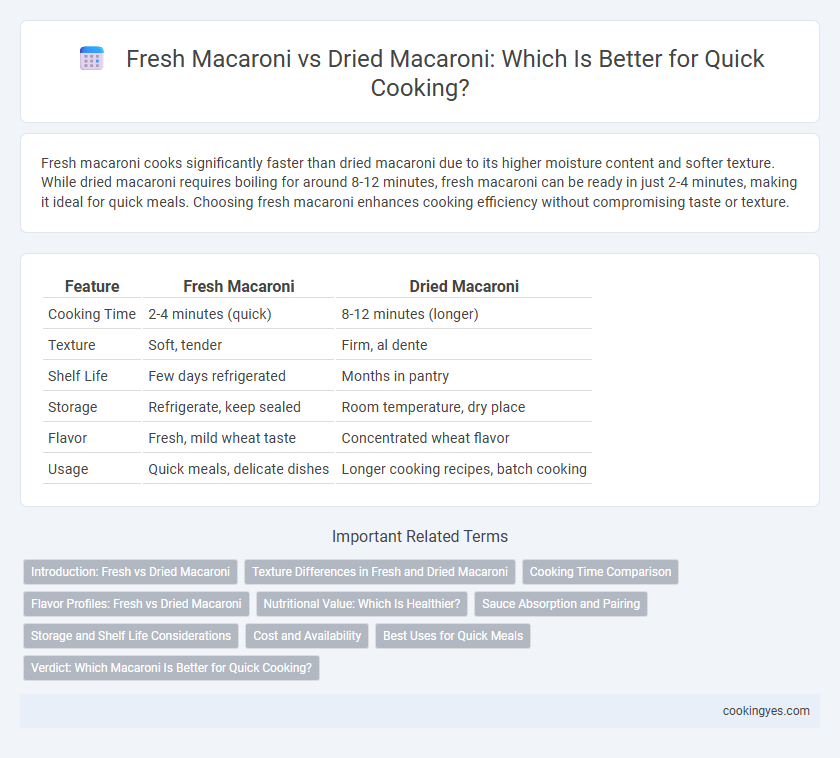Fresh macaroni cooks significantly faster than dried macaroni due to its higher moisture content and softer texture. While dried macaroni requires boiling for around 8-12 minutes, fresh macaroni can be ready in just 2-4 minutes, making it ideal for quick meals. Choosing fresh macaroni enhances cooking efficiency without compromising taste or texture.
Table of Comparison
| Feature | Fresh Macaroni | Dried Macaroni |
|---|---|---|
| Cooking Time | 2-4 minutes (quick) | 8-12 minutes (longer) |
| Texture | Soft, tender | Firm, al dente |
| Shelf Life | Few days refrigerated | Months in pantry |
| Storage | Refrigerate, keep sealed | Room temperature, dry place |
| Flavor | Fresh, mild wheat taste | Concentrated wheat flavor |
| Usage | Quick meals, delicate dishes | Longer cooking recipes, batch cooking |
Introduction: Fresh vs Dried Macaroni
Fresh macaroni, made from soft dough and cooked within hours of production, offers a tender texture and faster cooking time compared to dried macaroni. Dried macaroni undergoes a slow dehydration process, resulting in a firm texture and longer shelf life but requiring extended boiling, typically 8-12 minutes. Choosing fresh macaroni is ideal for quick meals, while dried macaroni suits recipes needing longer cooking or storage convenience.
Texture Differences in Fresh and Dried Macaroni
Fresh macaroni offers a tender, slightly chewy texture due to its higher moisture content, making it ideal for quick cooking and delicate dishes. Dried macaroni, with a firmer and more al dente bite, requires longer cooking time but holds its shape better in hearty recipes. The texture differences stem from the drying process, which reduces moisture and intensifies the pasta's density.
Cooking Time Comparison
Fresh macaroni typically cooks in 2 to 4 minutes due to its higher moisture content and softer texture, making it ideal for quick meals. Dried macaroni requires longer cooking times, usually 8 to 12 minutes, as it needs to rehydrate and soften during boiling. Choosing fresh macaroni significantly reduces overall meal preparation time compared to dried varieties.
Flavor Profiles: Fresh vs Dried Macaroni
Fresh macaroni offers a tender texture and a subtle wheat flavor that enhances delicate sauces, while dried macaroni provides a firmer bite and a nuttier, more concentrated taste ideal for hearty dishes. The moisture content in fresh pasta allows it to cook rapidly, preserving its light, fresh taste, whereas dried macaroni requires longer boiling but delivers robust flavor due to the drying process. Choosing between fresh and dried macaroni depends on the desired mouthfeel and flavor intensity in your quick-cooking recipes.
Nutritional Value: Which Is Healthier?
Fresh macaroni retains more moisture and often contains higher protein and vitamin content due to minimal processing, making it a nutrient-rich option. Dried macaroni, while shelf-stable and convenient, typically has a longer shelf life but may lose some heat-sensitive nutrients during dehydration. Choosing fresh macaroni can enhance nutritional intake, though dried macaroni remains a practical and healthy pantry staple.
Sauce Absorption and Pairing
Fresh macaroni absorbs sauce more effectively due to its porous texture, making it ideal for creamy or lighter sauces that cling well. Dried macaroni, with its denser structure, holds up better in robust, chunky sauces and long-simmered dishes, maintaining firmness without becoming mushy. For quick cooking, fresh macaroni pairs seamlessly with delicate flavors, while dried macaroni complements hearty, bold sauces in fast yet satisfying meals.
Storage and Shelf Life Considerations
Fresh macaroni requires refrigeration and has a shorter shelf life of about 2-3 days, making it less suitable for long-term storage but ideal for quick use. Dried macaroni can be stored in a cool, dry place for up to 1-2 years, offering greater convenience and longevity without refrigeration. Choosing between fresh and dried macaroni hinges on balancing immediate cooking needs with storage capacity and shelf life preferences.
Cost and Availability
Fresh macaroni typically costs more than dried macaroni and is less widely available, often found only in specialty or gourmet stores. Dried macaroni offers a more budget-friendly option with longer shelf life, making it easily accessible in most supermarkets. For quick cooking, both types work well, but dried macaroni is preferred due to its convenience and cost efficiency.
Best Uses for Quick Meals
Fresh macaroni cooks significantly faster than dried macaroni, making it ideal for quick meals that require minimal preparation time. Its tender texture suits dishes like creamy sauces or pasta salads where rapid cooking and soft consistency are preferred. Dried macaroni, while requiring a longer cooking time, holds up better in baked or saucier recipes, but fresh macaroni remains the top choice for fast, flavorful meals.
Verdict: Which Macaroni Is Better for Quick Cooking?
Fresh macaroni cooks significantly faster than dried macaroni, typically requiring just 2 to 4 minutes compared to 8 to 12 minutes for dried varieties. The higher moisture content in fresh macaroni allows for swift hydration and softening, making it ideal for quick meals. For time-sensitive cooking, fresh macaroni is the superior choice due to its rapid preparation and tender texture.
Fresh macaroni vs Dried macaroni for quick cooking Infographic

 cookingyes.com
cookingyes.com